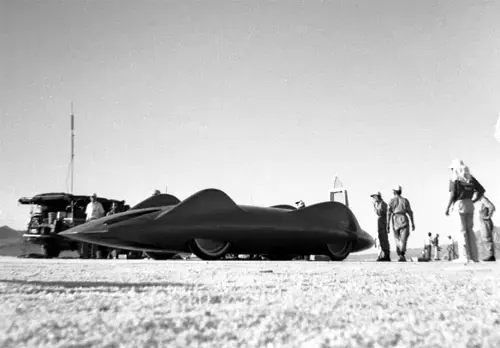
Bonneville 400mph Club Honours Dad
The American club has formed a new chapter to honour my father Donald Campbell
28 May 2012 Bonneville 400mph Club Honours Dad
The American club has formed a new chapter to honour my father Donald Campbell
Quite by chance, a lovely letter arrived in the post this week from the President of the Bonneville 200 MPH Club. The American club has formed a new chapter to honour my father – the 400 MPH Club.
Donald Campbell was included as a Charter Member of the Club at its annual banquet, held at the this autumn. Dan Warner, the Club President writes:
The Club is proud to have the world’s only Ultimate Land and Ultimate Water Speed Record Holder as a Member.
“At the annual meeting, older club members - some of whom remember Donald Campbell’s attempts at Bonneville - noted that even the younger members of the Club are still in awe of how much was accomplished by in so few years of active competition.”
“In recognition of your father’s election to the 400 MPH Chapter, the Club produced a special cap with Donald’s name and record speed embroidered on the side. Only Charter Members of the 400 Chapter will receive these special caps – a total of 14 people. We hope you will treasure this hat.”
And, of course, enclosed was one of the embroidered caps, which I shall treasure indeed. Warm thanks to all at [Bonneville 200 MPH C 200mph Club history.
The salt flats’ potential for racing was first recognized in 1896 by W.D. Rishel who was scouting a bicycle race course from New York to San Francisco. Rishel returned and convinced daredevil Teddy Tezlaff to attempt an automobile speed record on the flats. Tezlaff drove a Blitzen Benz 141.73 m.p.h. to set an unofficial record in 1914.
 The salt flats drew international attention in the 1930’s when Utah driver Ab Jenkins lured Sir Malcolm Campbell to compete for speed records on the salt surface. (Photos reveal he never wore appropriate shoes! They always look like le - By 1949, the raceway on the Bonneville Salt Flats was the standard course for world land speed records. A pioneering group of land speed racers laid the foundation for what has turned into one of the largest, and certainly fastest, motor sports events in the world. On this natural straightaway the 300, 400, 500, and 600 mile per hour land speed barriers were broken.
The salt flats drew international attention in the 1930’s when Utah driver Ab Jenkins lured Sir Malcolm Campbell to compete for speed records on the salt surface. (Photos reveal he never wore appropriate shoes! They always look like le - By 1949, the raceway on the Bonneville Salt Flats was the standard course for world land speed records. A pioneering group of land speed racers laid the foundation for what has turned into one of the largest, and certainly fastest, motor sports events in the world. On this natural straightaway the 300, 400, 500, and 600 mile per hour land speed barriers were broken.
The original idea for the formation of a club to recognise the accomplishments of drivers setting speed records over 200 mph on the Salt Flats was the brainchild of So-Cal Special driver, Dean Batchelor, and Hop Up magazine editor, Lou Kimsey. The go ahead and support came from Hop Up magazine publisher Bill Quinnin in 1953.
A review of the Club’s membership will find some of the most famous names in motorsports. Internationally recognised drivers Art Arfons, Craig Breedlove, Gary Gabelich, Don Garlits, Andy Granatelli and Andy Green are, of course, joined by and Donald Campbell.
But things didn’t always go according to plan...

Donald Healy, Phil Hill, Bobby Isaac, Sir Stirling Moss, Richard Noble, Mickey Thompson and Bobby Unser have all raced on the famous salt flats. A look at the membership roster finds family names spanning several generations. The club currently boasts 15 female members, proving that land speed racing is not an exclusive ‘boys club’.
Sir Malcolm's grandson aims for Bonneville
Since the first speed record attempts in 1914, hundreds of records have been set and broken in a var Typically, speed trials are scheduled throughout the summer and fall at the Bonneville Raceway. Most events are open to the public. The annual Speed Week is usually held in mid-August.
In 2013, Gina’s cousin will be attempting a World Speed Record at Bonneville Salt Flats with a new car, capable of speeds in excess of 400mph. So it won’t be long before he’s sporting a new cap too.